Choosing the correct cluster size allows you to more efficiently format the flash drive for later storing the necessary data on it. A properly selected cluster will allow you to save files on the storage medium as reliably as possible and organize a quick exchange of documents between the computer and the flash drive itself.

Instructions
Step 1
The choice of cluster should be based on the type of data that you are going to store on the flash drive. Cluster is the minimum amount of memory that is allocated on a storage medium for one file. For example, if a document has a volume of 1024 KB, and the cluster size was set to 2048 KB, then the file will completely occupy the entire volume of this cell, although in fact it has a smaller size.
Step 2
The larger the memory cell size, the less operations are performed to read data when copying and deleting data. The fewer operations are performed by the system, the faster the copy and write speed, which saves a little time.
Step 3
Before formatting, decide on the type of files that you will store on the flash drive. If you plan to use the media only as storage for digital copies of movies or music, you can select the maximum cluster size. You can find it in the formatting settings window, accessible by right-clicking on the device icon in the "Start" - "Computer" menu of the system.
Step 4
If you want to store small documents, for example, any reports, abstracts or small images, it is advisable to set a smaller cluster (for example, 4 KB). After choosing the cell size, click on the "Format" button to save the changes.
Step 5
If you are unsure what cluster size is best for you, leave this field at the default, which is medium and will balance the write speed with the amount of disk space consumed.






